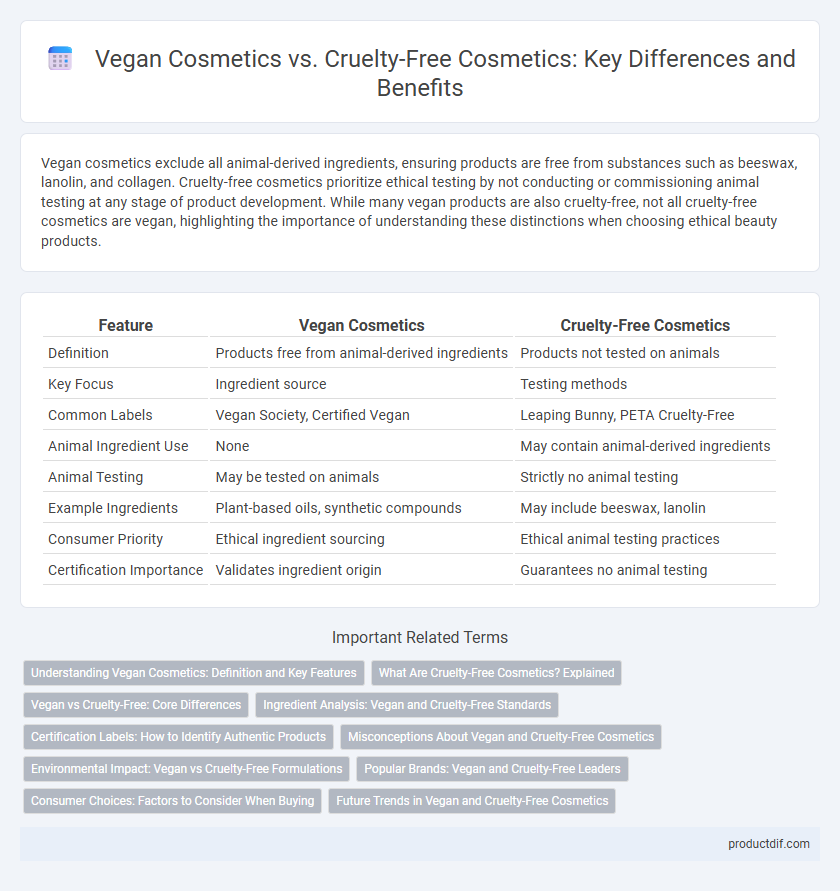Vegan cosmetics exclude all animal-derived ingredients, ensuring products are free from substances such as beeswax, lanolin, and collagen. Cruelty-free cosmetics prioritize ethical testing by not conducting or commissioning animal testing at any stage of product development. While many vegan products are also cruelty-free, not all cruelty-free cosmetics are vegan, highlighting the importance of understanding these distinctions when choosing ethical beauty products.
Table of Comparison
| Feature | Vegan Cosmetics | Cruelty-Free Cosmetics |
|---|---|---|
| Definition | Products free from animal-derived ingredients | Products not tested on animals |
| Key Focus | Ingredient source | Testing methods |
| Common Labels | Vegan Society, Certified Vegan | Leaping Bunny, PETA Cruelty-Free |
| Animal Ingredient Use | None | May contain animal-derived ingredients |
| Animal Testing | May be tested on animals | Strictly no animal testing |
| Example Ingredients | Plant-based oils, synthetic compounds | May include beeswax, lanolin |
| Consumer Priority | Ethical ingredient sourcing | Ethical animal testing practices |
| Certification Importance | Validates ingredient origin | Guarantees no animal testing |
Understanding Vegan Cosmetics: Definition and Key Features
Vegan cosmetics exclude all animal-derived ingredients such as beeswax, collagen, and lanolin, ensuring products are entirely plant-based or synthetic. Key features include the absence of animal by-products and adherence to ethical sourcing that supports sustainability and environmental preservation. These cosmetics often overlap with cruelty-free standards but specifically emphasize ingredient origin rather than animal testing practices.
What Are Cruelty-Free Cosmetics? Explained
Cruelty-free cosmetics are products developed without testing on animals at any stage of production, ensuring ethical standards in safety assessments. They are typically certified by organizations such as Leaping Bunny or PETA, which verify that no animal testing occurs by manufacturers or suppliers. Choosing cruelty-free cosmetics supports animal welfare and encourages the beauty industry to adopt humane practices.
Vegan vs Cruelty-Free: Core Differences
Vegan cosmetics exclude all animal-derived ingredients, focusing on plant-based components like aloe vera, jojoba oil, and shea butter, while cruelty-free products prioritize ethical testing practices, ensuring no animals are harmed during development. A product can be vegan without being cruelty-free if tested on animals, and cruelty-free without being vegan if containing animal-derived substances like beeswax or lanolin. Understanding the distinction helps consumers make informed choices based on ingredient content or animal testing ethics, depending on personal values.
Ingredient Analysis: Vegan and Cruelty-Free Standards
Vegan cosmetics exclude all animal-derived ingredients such as beeswax, lanolin, and collagen, ensuring formulations rely solely on plant-based or synthetic components. Cruelty-free standards focus on the ethical aspect, guaranteeing no animal testing during product development, regardless of ingredient origin. Ingredient analysis reveals vegan cosmetics prioritize plant-based purity, while cruelty-free products emphasize ethical testing practices, making both certifications essential for conscious consumers.
Certification Labels: How to Identify Authentic Products
Vegan cosmetics are certified by labels such as the Vegan Society Trademark or Certified Vegan, indicating no animal-derived ingredients are used, while cruelty-free products bear certifications like Leaping Bunny or PETA's Beauty Without Bunnies, ensuring no animal testing occurred during production. Authentic certification labels include a clear logo and registration number, often verifiable through official websites like Vegan Society or Cruelty Free International. Consumers should prioritize products with recognized certifications to guarantee ethical standards and ingredient transparency in both vegan and cruelty-free cosmetics.
Misconceptions About Vegan and Cruelty-Free Cosmetics
Misconceptions about vegan and cruelty-free cosmetics often confuse the two terms, but vegan cosmetics exclude animal-derived ingredients while cruelty-free products do not involve animal testing. Many consumers mistakenly believe all vegan products are cruelty-free, yet some vegan items are tested on animals, and some cruelty-free products may contain animal-derived ingredients. Understanding these distinctions is essential for making informed ethical and sustainable beauty choices.
Environmental Impact: Vegan vs Cruelty-Free Formulations
Vegan cosmetics exclude all animal-derived ingredients, significantly reducing the reliance on animal agriculture, which is a major contributor to greenhouse gas emissions and deforestation. Cruelty-free cosmetics prioritize the absence of animal testing but may still contain animal products with higher environmental footprints, such as beeswax or lanolin. Choosing vegan formulations supports lower environmental impact through sustainable sourcing and reduced ecological damage compared to some cruelty-free but non-vegan options.
Popular Brands: Vegan and Cruelty-Free Leaders
Popular vegan cosmetic brands like Tata Harper and 100% Pure emphasize plant-based, natural ingredients without animal derivatives. Leading cruelty-free brands such as Urban Decay and Too Faced commit to never testing products or ingredients on animals, certified by organizations like Leaping Bunny. Many top brands now combine both vegan and cruelty-free standards, appealing to ethical consumers seeking transparency and sustainability in beauty products.
Consumer Choices: Factors to Consider When Buying
Consumers choosing between vegan and cruelty-free cosmetics often prioritize ingredient transparency and ethical sourcing to align with personal values. Vegan cosmetics guarantee the absence of animal-derived ingredients, while cruelty-free products ensure no animal testing was involved in development. Evaluating labels, certifications like Leaping Bunny or Vegan Society, and brand commitment to sustainability helps consumers make informed, ethical choices.
Future Trends in Vegan and Cruelty-Free Cosmetics
Future trends in vegan and cruelty-free cosmetics include increased demand for plant-based ingredients and transparent sourcing among conscious consumers. Advances in biotechnology enable development of synthetic alternatives that mimic natural components without animal testing. Regulatory pressures and consumer awareness drive brands to adopt sustainable packaging and eco-friendly formulations to meet evolving ethical standards.
Vegan Cosmetics vs Cruelty-free Cosmetics Infographic

 productdif.com
productdif.com